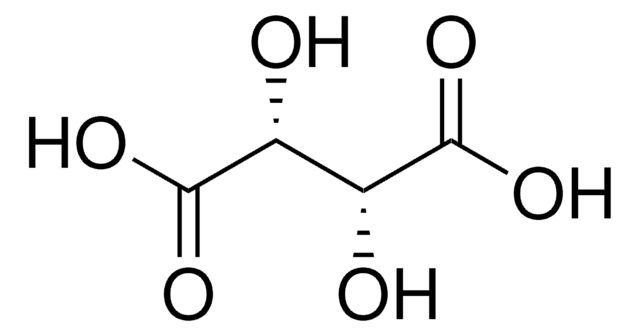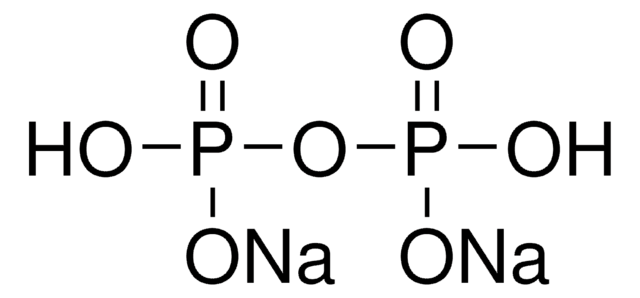T109
L-(+)-Tartaric acid
≥99.5%
Sinónimos:
(2R,3R)-(+)-Tartaric acid, L-Threaric acid
About This Item
Productos recomendados
densidad de vapor
5.18 (vs air)
Nivel de calidad
Ensayo
≥99.5%
Formulario
granular
powder or crystals
actividad óptica
[α]20/D +13.5±0.5°, c = 10% in H2O
temp. de autoignición
797 °F
mp
170-172 °C (lit.)
grupo funcional
carboxylic acid
hydroxyl
cadena SMILES
O[C@H]([C@@H](O)C(O)=O)C(O)=O
InChI
1S/C4H6O6/c5-1(3(7)8)2(6)4(9)10/h1-2,5-6H,(H,7,8)(H,9,10)/t1-,2-/m1/s1
Clave InChI
FEWJPZIEWOKRBE-JCYAYHJZSA-N
¿Está buscando productos similares? Visita Guía de comparación de productos
Descripción general
Aplicación
- A co-former for the synthesis of etravirine co-crystals.
- A mobile phase additive in thin-layer chromatography.
Palabra de señalización
Danger
Frases de peligro
Consejos de prudencia
Clasificaciones de peligro
Eye Dam. 1
Código de clase de almacenamiento
11 - Combustible Solids
Clase de riesgo para el agua (WGK)
WGK 1
Punto de inflamabilidad (°F)
302.0 °F - closed cup
Punto de inflamabilidad (°C)
150 °C - closed cup
Equipo de protección personal
dust mask type N95 (US), Eyeshields, Gloves
Elija entre una de las versiones más recientes:
¿Ya tiene este producto?
Encuentre la documentación para los productos que ha comprado recientemente en la Biblioteca de documentos.
Los clientes también vieron
Nuestro equipo de científicos tiene experiencia en todas las áreas de investigación: Ciencias de la vida, Ciencia de los materiales, Síntesis química, Cromatografía, Analítica y muchas otras.
Póngase en contacto con el Servicio técnico






